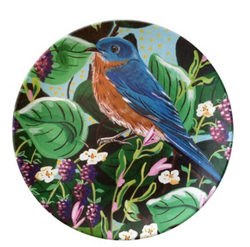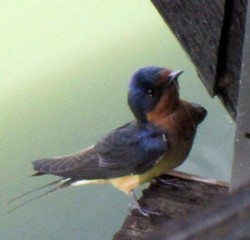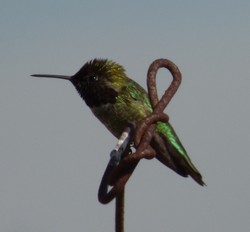We have three primary species of bluebirds which include the Western Bluebird, the Eastern Bluebird and the Mountain Bluebird. All these bluebirds are secondary cavity nesters – that means they rely on others to excavate the holes that they use for nesting and roosting. Because the number of natural places that are available to nest in are dwindling (due to humans cutting snags etc.) if you have no nesting cavities you get no bluebirds. This led to the first bluebird trails.

Attracting and Preserving Bluebirds
by MBC
Find out about attracting and preserving Bluebirds and learn about the three species of bluebirds here.
What is a Bluebird Trail?
There is a pretty long history of conservation of bluebirds. Both house sparrows and starlings were crowding out the bluebirds. The person credited with starting the bluebird trail was Thomas E. Musselman in 1934 when he placed nest boxes along a stretch of road in Adams County, Illinois. To try to reverse the decline, building bluebird boxes for them to nest in has helped. The long term decline in their population became evident in the 1960s. Building bluebird trails was the largest single-species conservation effort ever started. Another activist and educator who led the field in exposing their plight was Lawrence Zeleny. The North American Bluebird Society was formed and exists to this day. Populations are rebounding. Why not get involved, we could use your help.
The Mountain Bluebird
Mountain Bluebirds live generally above 7000 feet in elevation. This male bird is brilliant turquoise overall and a paler blue on the underparts. While the female has a white eye ring, and can be dull brown or grey with touches of blue mostly on the wings. It is at risk due to its declining nesting habitat, but they will nest in birdhouses, so please provide them. Sometimes they nest in the abandoned nests of swallows. They graze on grass, weeds, pine needles.
I guess I'm biased, but I think the Mountain Bluebirds is the prettiest one. Perhaps that's because I live in Colorado.
Mountain Bluebirds Video
The Eastern Bluebird
The gorgeous coloration of the Eastern Bluebird thrills observers. Their preferred habitat is open farmland which is disappearing but nesting boxes provided along bluebird trails has helped to maintain their population. They can spot a caterpillar from about 7 yards away and find them juicy morsels. They are often seen in flocks of 10 to 20. Most Eastern Bluebirds migrate south for the winter months. They don’t tolerate cold well and this can result in high mortality when winter storms come in.
Bluebirds love fruit – so this is a good way to attract them to your yard or feeder. Also mealworms are popular with bluebirds. Offering water and either fresh or dried fruit is a great way to make friends. They also like peanut or peanut butter mixes.
The Western Bluebird
You will find the Western Bluebird in brush, deserts and semi-open terrain in winter and the rest of the year in conifer forests, farms and scattered trees. One marking that distinguishes the Western Bluebird from the Eastern is that the Western has a brilliant blue throat and chestnut red underparts. The female is less colorful. With the decline of large old trees we have a dwindling population of Western Bluebirds. These birds will nest communally.
The Bluebird Effect by Julie Zickefoose
This is a must read book which would make a wonderful gift for any bird lover! It is chock full of great personal stories about birds such as of course the bluebird, tree swallow, osprey, starlings, tits, grosbeaks, tanagers, phoebes, plovers and terns as well as more. It's written by a woman who is an ornithologist and natural history buff.
Video of Bluebirds in Nestbox preparing to Fledge
Some of My Other Bird Related Pages
 Join Wizzley Today and Start Writing |
You might also like
The Barn SwallowMy favorite song bird or passerine is the barn swallow. See some of my photos...
Life of the HummingbirdHummingbirds are fascinating and enchanting little birds. This article will ...
















 Pelicans Are Funon 06/27/2016
Pelicans Are Funon 06/27/2016
 Blooms for Butterflies and Birdson 06/11/2016
Blooms for Butterflies and Birdson 06/11/2016


Your Comments on Bluebirds are Welcomed Here
I envy you, because I love Eastern Bluebirds and we don't have them, unless they are vagrants, here in Colorado.
MBC, Thank you!
Eastern bluebirds nearly died out when American chestnuts became blighted because Castanea dentata historically is their tree of choice. Unlike passenger pigeons, they ultimately found other alternatives. Year-round here, they love the mimosa in my side yard, and yesterday I witnessed one down the street singing from a dogwood while eyeballing some really fetching white bearded irises.
Yes, I agree!
It's always a great treat to spot a bluebird. They are such beautiful birds!
They are so gorgeous. I only see Mountain and Western here in Colorado above about 7,000 ft.
I would love to see a bluebird here in the Arizona desert. Hasn't happened yet. Informative article about attracting and preserving bluebirds. Thanks.
So worth it! They are so beautiful!
I agree! Thanks for visiting and commenting.
They are too cute! I hope their natural habitat stays in good enough condition, so our children can enjoy the company of bluebirds too.
They are well worth protecting.